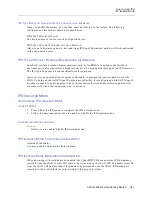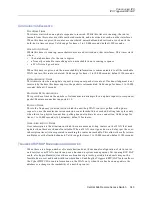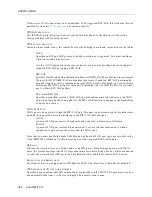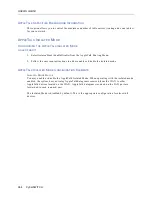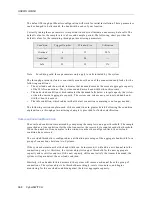
Central Site Remote Access Switch 355
C
ONFIGURING
SNMP
SNMP Background Information
Protocol (ICMP) group, the User Datagram Protocol (UDP) group, the Transmission Control
Protocol (TCP) group, and the Simple Network Management Protocol (SNMP) group.
Currently, each object in the above MIB-2 groups can be retrieved via an SNMP GetRequest or
GetNextRequest PDU. However, only the snmpEnableAuthenTraps object in the SNMP group can
be changed via the SNMP SetRequest PDU.
Note:
Any system object that is changed via an SNMP SetRequest will be returned to its initial
value when that system is restarted due to power loss or the action of an system operator.
The definition for the Enterprise portion of the MIB is given in the
ih_mib.asn
file on the system
software. The Enterprise MIB consists of four main groups: the ih000ConfigData group, which
contains the configuration data for the system; the ih000Statistics group, which contains run-time
statistics which are maintained by the system; the ih000StatusReports group, which can be used to
remotely display the report status log messages that appear at the administrative console when the
dr
command is entered; and the ihSystemMonitor group, which can be used to monitor system
status information such as the status of the system’s interfaces, the usage of ISDN B-channels, and
information regarding connected devices. Refer to the ASN.1 format of the Enterprise MIB in the
ih_mib.asn
file on the system software for more information on the Enterprise MIB.
In addition to the use of SNMP Request and Response PDUs to exchange data, the SNMP Agent
will also generate SNMP Trap PDUs to inform the Network Management Station of important
system events. Whenever such an event occurs, the appropriate SNMP Trap PDU will be sent to
each NMS that has been configured as a Trap Receiver using the CFGEDIT utility. The NMS that
receives the Trap can be attached to the same LAN as the sending system, or it can be attached to a
remote LAN.
The current set of Traps that the SNMP Agent will generate include generic traps and enterprise
traps. The following generic traps are available:
•
coldStart Trap
An Agent will generate a coldStart Trap PDU at startup time.
•
linkUp Trap
An SNMP Agent will generate a linkUp Trap PDU when the Agent detects that a new link has
been placed in service.
•
linkDown Trap
An SNMP Agent will generate a linkDown Trap PDU when the Agent detects that a link has
been removed from service.
•
authenticationFailure Trap
An SNMP Agent will generate an authenticationFailure Trap PDU when a PDU with an
unknown Community Name or an invalid MIB access level has been received.
The following enterprise traps are available:
•
isdnUsageHigh Trap
An SNMP Agent will generate an isdnUsageHigh Trap PDU when the Agent detects that the
number of B-Channels in use meets or exceeds the configured B-Channel threshold. The
enabling of this trap and its threshold value are configured through the CFGEDIT
configuration utility.
Содержание Cabletron CyberSWITCH CSX5500
Страница 684: ...USER S GUIDE 684 CyberSWITCH NETWORK TOPOLOGY...

